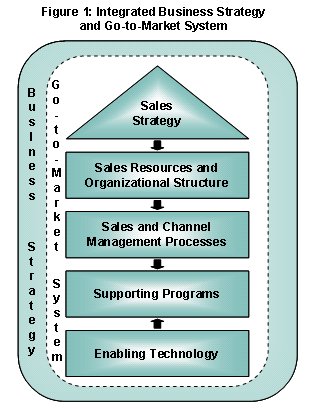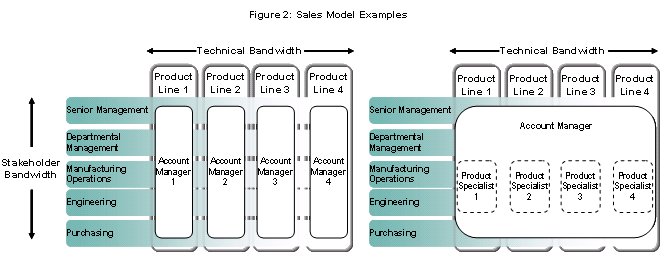In the current economic environment, management teams are evaluating and rationalizing every aspect of their organizations. The sales force and the broader "go-to-market" system1 are no exceptions.
Since the go-to-market system is the primary revenue generating function in the organization, companies must ensure that changes do not compromise customer coverage or satisfaction, profit margins or market share. As companies evaluate and reorganize their go-to-market systems and sales forces, we think it is critical to keep several thoughts in mind.
1. Structure Follows Strategy
Companies must view the go-to-market system within the context of their broader business strategy. Similarly, companies must design the structural and tactical elements of the go-to-market system so that they support their sales strategy (see Figure 1).
Many companies have experienced this over the last several years as their customers have transitioned from buying "boxes" to purchasing more holistic solutions. A healthcare equipment manufacturer learned that it could no longer simply sell to the technical buyers within their customer accounts as their customers transitioned from buying standalone equipment to purchasing integrated hardware and software solutions. They now had to meet with and sell to the IT and finance department along with other members of the "C" suite (e.g., CEO, CFO, CMO). They found that their technical sellers did not have the skills or the comfort selling to these new stakeholders. As a consequence, they had to recruit and hire account managers adept at selling consultatively.
Without a clear sales strategy, this healthcare supplier could not have successfully made the transition. They would not have been able to determine the type of skills they needed in their sales team, the changes they needed to make to their organizational structure to support them or the compensation models required to motivate and reward the desired behaviors.

2. Bandwidth is Critical
Companies expect a lot from their sales teams -- whether the team members are employees or salespeople working in an indirect channel (e.g., distributor, dealer, retailer). Manufacturers typically expect all these sales people to knowledgeably sell a variety of products, interact with many different influencers and end users and perform a variety of different functions (e.g., educate customers, create specifications, induce trial, sell consultatively, take orders). All these demands stress the capabilities and "bandwidth" of a salesperson.
When pushed too far, sales people cannot successfully perform their roles and they make trade-offs. The trade-offs vary, but inevitably they compromise the integrity of the company's sales strategy. Consequently, companies must define the roles and responsibilities of each sales position with a focus on effectiveness (i.e., the right competencies and skill sets) and consistency (i.e., adequate time). A variety of different sales models exist (see Figure 2), and defining the right one depends on many factors. These factors include the number and type of stakeholders involved in the buying process, the range of sales functions that the sales people must perform and the technical complexity of the products and services.
For the healthcare equipment supplier, they realized that their account managers needed the support of product specialists to enable them to sell successfully. When an opportunity involves multiple products, the account managers now coordinate the activities of the various product specialists at the appropriate times during the sales process. The account managers are responsible for orchestrating and driving the sales process and the product specialists are responsible for delivering the right content at the right time.

3. The Critical Four Functions
To create and execute a go-to-market strategy successfully, companies must ensure that their organizations perform four critical functions—channel governance, channel marketing, channel management and channel sales.
The channel governance function is responsible for defining the overall go-to-market strategy and the policies and programs that support it (e.g., type of channels used, channel assignment, compensation models). The channel marketing function creates and implements all of the programs that support the go-to-market strategy (e.g., training, sales tools, marketing communication pieces, trade shows). Without proper ownership and coordination of these functions, companies default to ad hoc and inconsistent strategies, policies and programs.
Channel management involves managing, mentoring and coaching both direct and indirect sales resources. The skill set and competencies required to manage direct sales people is different from those required to manage indirect channel relationships. Consequently, these functions and the personnel responsible for them are often different.
Companies that sell through indirect sales channels must also help their channels' sales representatives sell their products. To be successful with many types of channel partners, suppliers must ensure that they create account plans, conduct joint sales calls with the channel's salespeople and support partner marketing and sales events.
4. The Organizational Structure Dilemma
Companies can organize their sales resources along a number of different dimensions or combinations of them—geography, product line, customer type, customer size, channel, application. To enable the sales people to execute the sales strategy, a company must select the dimension or combination of dimensions that best facilitate the required sales activities.
Each option has its strengths and weaknesses. Sales organizations aligned by product line/product group, for example, ensure that each product group controls its sales people and has a direct "line of sight" to the customer. This structure, however, can inhibit account coordination, engender a product-centric rather than customer-centric approach and increase sales costs. Customers that buy products from several of the company's product lines/product groups often witness "multi-car pile-ups" as the different salespeople enter and leave their parking lot.
Sales organizations structured geographically typically enhance market coverage, simplify coordination and improve efficiency. However, if the salespeople represent multiple product lines, then each product group cedes control of them to the geographic sales leaders. In this structure, product line leaders are forced to jockey for position to capture the hearts and minds of the sales team.
To bridge the gap between product-line focused and geographic-based sales structures, many companies use an account "quarterback" approach, at least for their large customers. In this model, a single, senior salesperson assumes ultimate responsibility for the account, calling upon specialists, as needed.
Given the many different ways that a company can organize its sales team, the ultimate arbiter is the customer. Companies need to segment their target customers based on each segment's buying processes, information needs, channel preferences, etc.
Companies reorganizing their sales force must keep an eye on effectiveness as well as efficiency. Without the proper market perspectives and a guiding sales strategy, it is difficult to make the right changes.
Footnote
1. A company's "go-to-market" system includes its direct channels (field sales, telesales, web, etc.), its indirect channels (distributors, dealers, retailers, etc.), and all the associated marketing and support programs
The content of this article is intended to provide a general guide to the subject matter. Specialist advice should be sought about your specific circumstances.
